

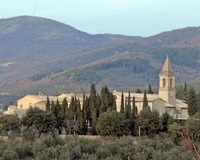
This was the site of the ancient San Martino della Pieve, the original parish church of Trevi, which was first documented in 1235. Its function and its goods passed to Sant’ Emiliano in 1430.
Fr Agostino, an Observant Franciscan from Perugia, preached in Trevi in 1469 to such good effect that the the Consiglio dei Priori (Town Council) decided to invite his order to establish a convent near Trevi. At this time the site of San Martino della Pieve seems to have belonged to the Abbazia di San Pietro in Bovara, because it was Tommaso Valenti, the abbot of San Pietro, who ceded this site to the Observant Franciscans in 1479, with the approval of Pope Sixtus IV.
Fr Bernardino da Feltre stayed here in 1487, when his preaching in Trevi against corruption and social discord led to the reformation of the civic statutes.
[In 1612, Pope Paul V transferred the convent to the Minori della Riforma.]
[Later history?]
Exterior

Cesare Minerva built the Cappella di San Girolamo in the square in front of the church (on the left) in 1512. It was closed to the public and incorporated into the convent in 1723 but reopened in 1837.
The portico of the church and the facade above were built in the 18th century.
Madonna and Child with angels (16th century)
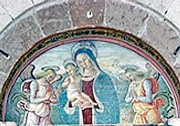
This fresco, which is signed by Tiberio d' Assisi, is in the lunette above the entrance. The inscription also records that it was commissioned by "Ioannes Baptista Mag... de Trevio".
Interior of the Church
The interior was re-modelled in the late 16th century.
Fresco fragments (1488)
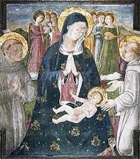
St Martin (16th century)
This detached fresco in the presbytery, which depicts St Martin sharing his cloak with a beggar, is attributed to Tiberio d' Assisi.
Immaculate Conception (1522)
Girolamo Fabri commissioned this altarpiece, which is now on the high altar, from Ascensidonio Spacca, il Fantino. It was originally in the 1st chapel on the right.
Cappella di San Girolamo
An inscription records that the Minerva family commissioned this chapel in 1512. It was closed to the public and incorporated into the convent in 1723, but re-opened in 1837.
The chapel was closed during my last visit. I am grateful to Signor Franco Spellani for allowing me to use these photographs from the website of Pro Trevi.
Assumption of the Virgin (1512)
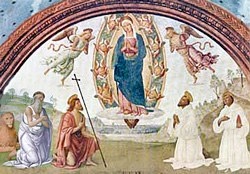
This fine fresco, which is attributed to Giovanni di Pietro, Lo Spagna and dated by inscription, is in a lunette on the left. Four saints witness the Assumption of the Virgin:
-
✴SS Jerome (with his lion) and John the Baptist on the left; and
-
✴SS Francis and Antony of Padua (both of whom, unusually, wear white habits) on the right.

The scene is set in a landscape outside Trevi, with Foligno, as seen from San Martino, in the distance.
St Emilianus (16th century)
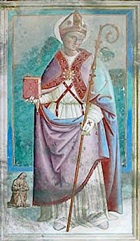
Convent
Last Supper (1601)
This fresco in the old refectory by Ascensidonio Spacca, il Fantino.
Frescoes (1601)
These frescoes of the stigmatisation of St Francis and 26 tondi containing Franciscan saints in the cloister are by Ascensidonio Spacca, il Fantino.
Art from the Church
San Martino Dossal (13th century)
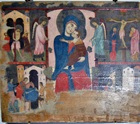
This dossal depicts the Madonna and Child with four scenes to the sides:
-
✴two scenes from the life of Christ (the Flagellation and the Crucifixion) above; and
-
✴two scenes from the life of St Martin, only one of which (St Martin gives part of his cloak to a poor man, on the left) is still legible.
It is now in the Museo Diocesano, Spoleto.
Coronation of the Virgin (1522)
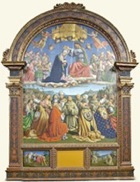
The main panel of the altarpiece is clearly based on that of lo Spagna's altarpiece at Santa Maria di Montesanto, Todi, albeit that the lower part of it has been inverted. This, in turn, had been based on the altarpiece (1486) that Domenico Ghirlandaio had painted for the Observant Franciscans of San Girolamo, Narni.
-
✴In the upper part, Christ crowns the Virgin to the accompaniment of musical angels.
-
✴The lower part is set in a landscape of the Valle Umbra, with San Francesco, Assisi clearly visible to the right. Here, a group of kneeling saints meditate on the coronation:
-
•St Francis, kneeling at the centre;
-
•SS Martin (the titular of the church) and Bernardino of Siena immediately behind him (to the left and right respectively);
-
•SS Mary Magdalene, Bonaventure, John the Baptist and Jerome on the left;
-
• SS Augustine, Antony of Padua, Louis of Toulouse and Catherine of Alexandria on the right; and
-
•a number of Franciscan saints behind.
The predella panels in the Pinacoteca depict:
-
✴St Martin and the beggar; and
-
✴the stigmatisation of St Francis.

